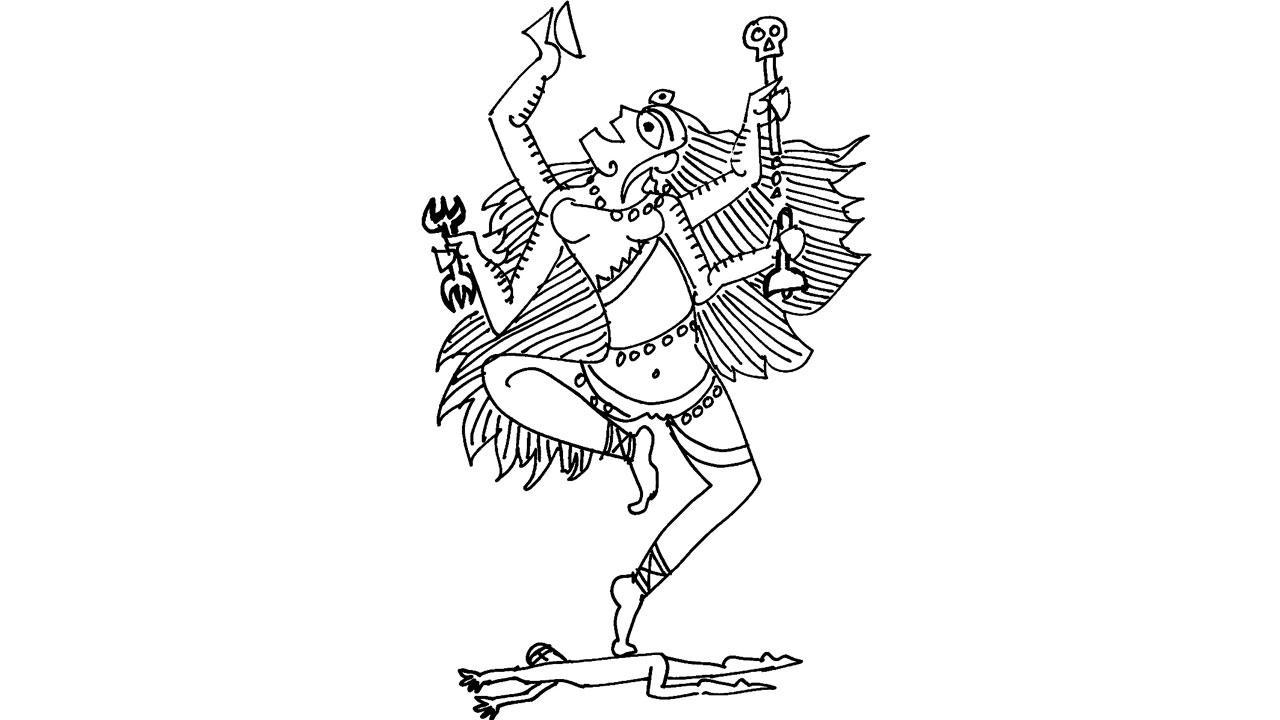They reveal that Buddhism has all kinds of forms, not all pacifist.

Illustration/Devdutt Pattanaik
 When today, people talk of Buddhism, they are stuck in the 19th century understanding of Buddhism, which is based on the translation of Pali scriptures, especially the Tripitaka and the Jataka tales. These form the bulk of the oldest form of Buddhism known as Theravada, the way of the elders. However, in its long history of 2,500 years, Buddhism has had many schools of thought, many ideas which manifest in different kinds of texts and artworks. They reveal that Buddhism has all kinds of forms, not all pacifist.
When today, people talk of Buddhism, they are stuck in the 19th century understanding of Buddhism, which is based on the translation of Pali scriptures, especially the Tripitaka and the Jataka tales. These form the bulk of the oldest form of Buddhism known as Theravada, the way of the elders. However, in its long history of 2,500 years, Buddhism has had many schools of thought, many ideas which manifest in different kinds of texts and artworks. They reveal that Buddhism has all kinds of forms, not all pacifist.
It is important to make note Buddhism was patronised by kings who knew the importance of power. This power was gathered through violence. Therefore, we find Buddha or Buddha-like images holding weapons in royal Buddhist art.
As the old school gave way to what is called the Mahayana school, we find there are guardian Bodhisattvas like Vajrapani. The word Vajrapani means someone who bears the thunderbolt in his hand. Therefore, he is shown with a club, a staff or a spear. Vajrapani is a powerful deity who protects the Buddha from people who insult him or want to hurt him. He’s shown in a rather aggressive form. Some people believed that he could be identified with Zeus or Hercules from Greek mythology, for many Greek artisans moved to Gandhara after they were persecuted in Egypt following the rise of Christianity around the 3rd century AD. Vajrapani was also identified with Indra in the Indian subcontinent as Hindu gods like Indra were seen to be bowing to Buddha.
Vajrapani transforms dramatically as Hevajra and later Heruka, in the Tibetan traditions which rise from the 8th to 9th century. The Tibetan world clearly had very antagonistic relations with the Hindus. We find that places like Rishikesh, Badrinath, Kedarnath mark the frontier between the Hindu world and the Tibetan Buddhist world. This Tibetan Buddhist world is full of violent gods who are protectors of Buddhists like Mahakaal. They all hold weapons of different kinds like the axe, the sword, the trident, the skull-capped Khadwanga. These attributes are very similar to that of Shiva. The gods are shown in violent form with multiple heads and hands trampling Hindu gods like Brahma, Vishnu, Shiva, Indra, Ganesha. This is typically found in the Tibetan plateau, and we do not talk about them much.
Another Bodhisattva Manjushri is shown holding a flaming sword but his violence is more conceptual,he is the destroyer of ignorance.
So Vajrapani, Heruka and Manjushri all hold weapons in their hands. There are even goddesses or dakinis in Tibetan Buddhism holding a bow like Kurukulla popular in tantric practices.
While people have paid a lot of attention to the sexual part of Tantra, few people pay attention to the violent part of Tantra and its association with death. These emerged, as Hinduism clashed with Buddhism, around the 10th century. Memories of these manifest as mythological stories.
In fact, some people have argued that the Char Dhams of Hinduism really mark the four spots which mark the frontier between Hinduism and Buddhism which is Badrinath, Puri, Rameshwaram and Dwarka, beyond which Buddhism thrived. Vajrayana Buddhism in the north and the east, Theravada Buddhism in the south, Mahayana Buddhism in the northwest part of India, that gradually was replaced with Islam.
Devdutt Pattanaik writes and lectures on the relevance of mythology in modern times. Reach him at devdutt.pattanaik@mid-day.com
 Subscribe today by clicking the link and stay updated with the latest news!" Click here!
Subscribe today by clicking the link and stay updated with the latest news!" Click here!








